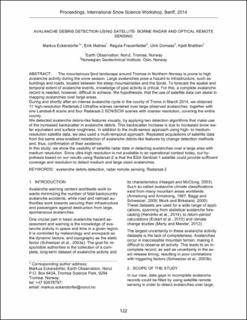| dc.description.abstract | The mountainous fjord landscape around Tromsø in Northern Norway is prone to high avalanche activity during the snow season. Large avalanches pose a hazard to infrastructure, such as buildings and roads, located between the steep mountainsides and the fjords. To forecast the spatial and temporal extent of avalanche events, knowledge of past activity is critical. For this, a complete avalanche record is needed, however, difficult to achieve. We hypothesize, that the use of satellite data can assist in mapping avalanches over large areas. During and shortly after an intense avalanche cycle in the county of Troms in March 2014, we obtained 11 high-resolution Radarsat-2 Ultrafine scenes centered over large observed avalanches, together with one Landsat-8 scene and four Radarsat-2 SCN/SCW scenes with coarser resolution, covering the entire county. We detected avalanche debris-like features visually, by applying two detection algorithms that make use of the increased backscatter in avalanche debris. This backscatter increase is due to increased snow water equivalent and surface roughness. In addition to the multi-sensor approach using high- to mediumresolution satellite data, we also used a multi-temporal approach. Repeated acquisitions of satellite data from the same area enabled redetection of avalanche debris-like features by change detection methods and, thus, confirmation of their existence. In this study, we show the usability of satellite radar data in detecting avalanches over a large area with medium resolution. Since ultra-high resolution is not available in an operational context today, our hypothesis based on our results using Radarsat-2 is that the ESA Sentinel-1 satellite could provide sufficient coverage and resolution to detect medium and large sized avalanches. | en_US |
